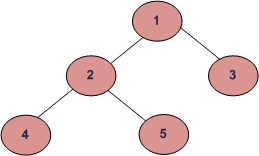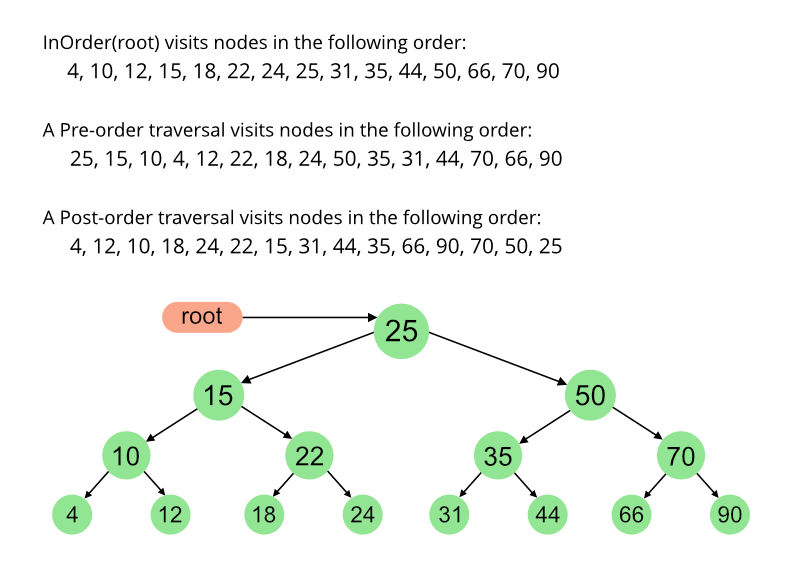本文概述
与只有一种逻辑方式遍历线性数据结构(数组, 链表, 队列, 栈等)的树不同, 可以以不同的方式遍历树。以下是遍历树的常用方法。

树示例
深度优先遍历:
(a)先序遍历(左, 根, 右):4 2 5 1 3
(b)中序遍历(根, 左, 右):1 2 4 5 3
(c)后续遍历(左, 右, 根):4 5 2 3 1
广度优先或级别顺序遍历:1 2 3 4 5
请参阅这篇文章了解广度优先遍历。
先序遍历(实践):
Algorithm Inorder(tree)
1. Traverse the left subtree, i.e., call Inorder(left-subtree)
2. Visit the root.
3. Traverse the right subtree, i.e., call Inorder(right-subtree)中序遍历的使用
对于二叉搜索树(BST), 中序遍历以非递减的顺序给出节点。为了以非递增的顺序获取BST节点,可以使用中序遍历的一种变体,即中序遍历的反转。
示例:上面给出的数字的顺序遍历为4 2 5 1 3。
先序遍历:
Algorithm Preorder(tree)
1. Visit the root.
2. Traverse the left subtree, i.e., call Preorder(left-subtree)
3. Traverse the right subtree, i.e., call Preorder(right-subtree)先序遍历的用法
先序遍历遍历用于创建树的副本。先序遍历还用于在表达式树上获取前缀表达式。请参阅:http://en.wikipedia.org/wiki/Polish_notation了解为什么前缀表达式有用。
示例:上图给定的遍历为1 2 4 5 3。
Algorithm Postorder(tree)
1. Traverse the left subtree, i.e., call Postorder(left-subtree)
2. Traverse the right subtree, i.e., call Postorder(right-subtree)
3. Visit the root.后序遍历
后序遍历用于删除树。请参阅删除树的问题
有关详细信息。后序遍历对于获取表达式树的后缀表达式也很有用。请参阅http://en.wikipedia.org/wiki/Reverse_Polish_notation了解后缀表达式的用法。
示例:上图给定的事后遍历为4 5 2 3 1。
C++
// C program for different tree traversals
#include <iostream>
using namespace std;
/* A binary tree node has data, pointer to left child
and a pointer to right child */
struct Node
{
int data;
struct Node* left, *right;
Node( int data)
{
this ->data = data;
left = right = NULL;
}
};
/* Given a binary tree, print its nodes according to the
"bottom-up" postorder traversal. */
void printPostorder( struct Node* node)
{
if (node == NULL)
return ;
// first recur on left subtree
printPostorder(node->left);
// then recur on right subtree
printPostorder(node->right);
// now deal with the node
cout << node->data << " " ;
}
/* Given a binary tree, print its nodes in inorder*/
void printInorder( struct Node* node)
{
if (node == NULL)
return ;
/* first recur on left child */
printInorder(node->left);
/* then print the data of node */
cout << node->data << " " ;
/* now recur on right child */
printInorder(node->right);
}
/* Given a binary tree, print its nodes in preorder*/
void printPreorder( struct Node* node)
{
if (node == NULL)
return ;
/* first print data of node */
cout << node->data << " " ;
/* then recur on left sutree */
printPreorder(node->left);
/* now recur on right subtree */
printPreorder(node->right);
}
/* Driver program to test above functions*/
int main()
{
struct Node *root = new Node(1);
root->left = new Node(2);
root->right = new Node(3);
root->left->left = new Node(4);
root->left->right = new Node(5);
cout << "\nPreorder traversal of binary tree is \n" ;
printPreorder(root);
cout << "\nInorder traversal of binary tree is \n" ;
printInorder(root);
cout << "\nPostorder traversal of binary tree is \n" ;
printPostorder(root);
return 0;
}C
// C program for different tree traversals
#include <stdio.h>
#include <stdlib.h>
/* A binary tree node has data, pointer to left child
and a pointer to right child */
struct node
{
int data;
struct node* left;
struct node* right;
};
/* Helper function that allocates a new node with the
given data and NULL left and right pointers. */
struct node* newNode( int data)
{
struct node* node = ( struct node*)
malloc ( sizeof ( struct node));
node->data = data;
node->left = NULL;
node->right = NULL;
return (node);
}
/* Given a binary tree, print its nodes according to the
"bottom-up" postorder traversal. */
void printPostorder( struct node* node)
{
if (node == NULL)
return ;
// first recur on left subtree
printPostorder(node->left);
// then recur on right subtree
printPostorder(node->right);
// now deal with the node
printf ( "%d " , node->data);
}
/* Given a binary tree, print its nodes in inorder*/
void printInorder( struct node* node)
{
if (node == NULL)
return ;
/* first recur on left child */
printInorder(node->left);
/* then print the data of node */
printf ( "%d " , node->data);
/* now recur on right child */
printInorder(node->right);
}
/* Given a binary tree, print its nodes in preorder*/
void printPreorder( struct node* node)
{
if (node == NULL)
return ;
/* first print data of node */
printf ( "%d " , node->data);
/* then recur on left sutree */
printPreorder(node->left);
/* now recur on right subtree */
printPreorder(node->right);
}
/* Driver program to test above functions*/
int main()
{
struct node *root = newNode(1);
root->left = newNode(2);
root->right = newNode(3);
root->left->left = newNode(4);
root->left->right = newNode(5);
printf ( "\nPreorder traversal of binary tree is \n" );
printPreorder(root);
printf ( "\nInorder traversal of binary tree is \n" );
printInorder(root);
printf ( "\nPostorder traversal of binary tree is \n" );
printPostorder(root);
getchar ();
return 0;
}python
# Python program to for tree traversals
# A class that represents an individual node in a
# Binary Tree
class Node:
def __init__( self , key):
self .left = None
self .right = None
self .val = key
# A function to do inorder tree traversal
def printInorder(root):
if root:
# First recur on left child
printInorder(root.left)
# then print the data of node
print (root.val), # now recur on right child
printInorder(root.right)
# A function to do postorder tree traversal
def printPostorder(root):
if root:
# First recur on left child
printPostorder(root.left)
# the recur on right child
printPostorder(root.right)
# now print the data of node
print (root.val), # A function to do preorder tree traversal
def printPreorder(root):
if root:
# First print the data of node
print (root.val), # Then recur on left child
printPreorder(root.left)
# Finally recur on right child
printPreorder(root.right)
# Driver code
root = Node( 1 )
root.left = Node( 2 )
root.right = Node( 3 )
root.left.left = Node( 4 )
root.left.right = Node( 5 )
print "Preorder traversal of binary tree is"
printPreorder(root)
print "\nInorder traversal of binary tree is"
printInorder(root)
print "\nPostorder traversal of binary tree is"
printPostorder(root)Java
// Java program for different tree traversals
/* Class containing left and right child of current
node and key value*/
class Node
{
int key;
Node left, right;
public Node( int item)
{
key = item;
left = right = null ;
}
}
class BinaryTree
{
// Root of Binary Tree
Node root;
BinaryTree()
{
root = null ;
}
/* Given a binary tree, print its nodes according to the
"bottom-up" postorder traversal. */
void printPostorder(Node node)
{
if (node == null )
return ;
// first recur on left subtree
printPostorder(node.left);
// then recur on right subtree
printPostorder(node.right);
// now deal with the node
System.out.print(node.key + " " );
}
/* Given a binary tree, print its nodes in inorder*/
void printInorder(Node node)
{
if (node == null )
return ;
/* first recur on left child */
printInorder(node.left);
/* then print the data of node */
System.out.print(node.key + " " );
/* now recur on right child */
printInorder(node.right);
}
/* Given a binary tree, print its nodes in preorder*/
void printPreorder(Node node)
{
if (node == null )
return ;
/* first print data of node */
System.out.print(node.key + " " );
/* then recur on left sutree */
printPreorder(node.left);
/* now recur on right subtree */
printPreorder(node.right);
}
// Wrappers over above recursive functions
void printPostorder() { printPostorder(root); }
void printInorder() { printInorder(root); }
void printPreorder() { printPreorder(root); }
// Driver method
public static void main(String[] args)
{
BinaryTree tree = new BinaryTree();
tree.root = new Node( 1 );
tree.root.left = new Node( 2 );
tree.root.right = new Node( 3 );
tree.root.left.left = new Node( 4 );
tree.root.left.right = new Node( 5 );
System.out.println( "Preorder traversal of binary tree is " );
tree.printPreorder();
System.out.println( "\nInorder traversal of binary tree is " );
tree.printInorder();
System.out.println( "\nPostorder traversal of binary tree is " );
tree.printPostorder();
}
}C#
// C# program for different
// tree traversals
using System;
/* Class containing left and
right child of current
node and key value*/
class Node
{
public int key;
public Node left, right;
public Node( int item)
{
key = item;
left = right = null ;
}
}
class BinaryTree
{
// Root of Binary Tree
Node root;
BinaryTree()
{
root = null ;
}
/* Given a binary tree, print
its nodes according to the
"bottom-up" postorder traversal. */
void printPostorder(Node node)
{
if (node == null )
return ;
// first recur on left subtree
printPostorder(node.left);
// then recur on right subtree
printPostorder(node.right);
// now deal with the node
Console.Write(node.key + " " );
}
/* Given a binary tree, print
its nodes in inorder*/
void printInorder(Node node)
{
if (node == null )
return ;
/* first recur on left child */
printInorder(node.left);
/* then print the data of node */
Console.Write(node.key + " " );
/* now recur on right child */
printInorder(node.right);
}
/* Given a binary tree, print
its nodes in preorder*/
void printPreorder(Node node)
{
if (node == null )
return ;
/* first print data of node */
Console.Write(node.key + " " );
/* then recur on left sutree */
printPreorder(node.left);
/* now recur on right subtree */
printPreorder(node.right);
}
// Wrappers over above recursive functions
void printPostorder() {printPostorder(root);}
void printInorder() {printInorder(root);}
void printPreorder() {printPreorder(root);}
// Driver Code
static public void Main(String []args)
{
BinaryTree tree = new BinaryTree();
tree.root = new Node(1);
tree.root.left = new Node(2);
tree.root.right = new Node(3);
tree.root.left.left = new Node(4);
tree.root.left.right = new Node(5);
Console.WriteLine( "Preorder traversal " +
"of binary tree is " );
tree.printPreorder();
Console.WriteLine( "\nInorder traversal " +
"of binary tree is " );
tree.printInorder();
Console.WriteLine( "\nPostorder traversal " +
"of binary tree is " );
tree.printPostorder();
}
}
// This code is contributed by Arnab Kundu输出如下:
Preorder traversal of binary tree is
1 2 4 5 3
Inorder traversal of binary tree is
4 2 5 1 3
Postorder traversal of binary tree is
4 5 2 3 1再举一个例子:

时间复杂度:O(n)
让我们看看不同的极端情况。
对于涉及树遍历的所有问题, 复杂度函数T(n)可以定义为:
T(n)= T(k)+ T(n – k – 1)+ c
其中k是根的一侧上的节点数, 而n-k-1在另一侧上。
让我们来分析边界条件
情况1:倾斜的树(子树之一为空, 其他子树为非空)
在这种情况下, k为0。
T(n)= T(0)+ T(n-1)+ c
T(n)= 2T(0)+ T(n-2)+ 2c
T(n)= 3T(0)+ T(n-3)+ 3c
T(n)= 4T(0)+ T(n-4)+ 4c
…………………………………………
…………………………………………。
T(n)=(n-1)T(0)+ T(1)+(n-1)c
T(n)= nT(0)+(n)c
T(0)的值将是一个常数, 例如d。 (遍历一棵空树将花费一些常量时间)
T(n)= n(c + d)
T(n)=Θ(n)(n的θ)
情况2:左右子树的节点数相等。
T(n)= 2T(| _n / 2_ |)+ c
对于主方法, 此递归函数为标准形式(T(n)= aT(n / b)+(-)(n))http://en.wikipedia.org/wiki/Master_theorem。如果我们通过主方法解决它, 我们得到(-)(n)
辅助空间:如果我们不考虑函数调用的栈大小, 则为O(1)否则为O(n)。

![从字法上最小长度N的排列,使得对于正好为K个索引,a[i] a[i]+1](https://www.lsbin.com/wp-content/themes/begin%20lts/img/loading.png)